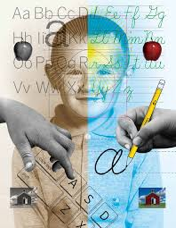Year 5-7
Scientists are discovering that learning cursive is an important tool for cognitive development, particularly in training the brain to learn “functional specialization” — the capacity for optimal efficiency

Recent research illustrates how writing by hand engages the brain in learning. During one study at Indiana University published this year, researchers invited children to man a "spaceship," actually an MRI machine using a specialized scan called "functional" MRI that spots neural activity in the brain. The kids were shown letters before and after receiving different letter-learning instruction. In children who had practiced printing by hand, the neural activity was far more enhanced and "adult-like" than in those who had simply looked at letters.
"It seems there is something really important about manually manipulating and drawing out two-dimensional things we see all the time," says Karin Harman James, assistant professor of psychology and neuroscience at Indiana University who led the study.
Other research highlights the hand's unique relationship with the brain when it comes to composing thoughts and ideas. Virginia Berninger, a professor of educational psychology at the University of Washington, says handwriting differs from typing because it requires executing sequential strokes to form a letter, whereas keyboarding involves selecting a whole letter by touching a key.
She says pictures of the brain have illustrated that sequential finger movements activated massive regions involved in thinking, language and working memory — the system for temporarily storing and managing information. And one recent study of hers demonstrated that in grades two, four and six, children wrote more words, faster, and expressed more ideas when writing essays by hand versus with a keyboard.
How I think @ 5-6 yrs
Your child now has longer attention spans and continues to prefer structured activities to more open-ended experiences. He enjoys taking on new roles and responsibilities, but still requires much direction from adults and frequently asks questions to ensure that he is completing tasks the right way. As he approaches the first grade, he will transform into a true reader. He will apply his knowledge of how print works and practice strategies to decode unfamiliar words. He will learn to read aloud with fluency, accuracy and understanding. He may even write stories, notes and descriptions. He may be able to develop an idea beyond a sentence and add some details to help describe or explain things in his world. He may enjoy sharing his writing with others.
Motor Development: Gross Motor Skills
• I can complete somersault with chin tuck and without turning to side
• I can gallop 10 feet with weight transferred smoothly and evenly; arms move freely in opposition lo legs
• I can jump and turn so feet land in opposite direction from starting position (180 degree turn in the air)
• I can hop 8 consecutive times on one foot followed by 8 hops on other foot
• I can skip 8 steps using opposing arm and leg movements and using alternating feet while maintaining balance
• I can hit a target with tennis ball 12 feet away using overhead throw
• I can catch a tennis ball with hands only from 5 feet away
• I can run while pumping arms
Motor Development: Fine Motor Skills
• I use a refined and fluid grasp on crayons/pencil (dynamic tripod grasp)
• I can imitate a triangle
• I can print my own name
• I print 10-19 letters per minute
• I can draw a picture of at least 3 objects
• I can cut with a knife
• I place shoes on correct feet and lace shoes
• I play games with rules (Candyland, Checkers, Kickball)
Language and Thinking Development
• I make a plan before starting a project
• My attention span is 12 to 28 minutes long
• I like to play the same thing for more than one day
• My pretend play is more realistic
• I easily use complete sentences
• I can count 10 objects
Social and Emotional Development
• I am less competitive than at age 4
• I am sensitive to teasing and get hurt feelings easily
• I like the companionship of adults
• I have to be right
• I am sociable and like to visit
Activities
Disclaimer: This presents an overview of child development. It is important to keep in mind that the time frames presented are averages and some children may achieve various developmental milestones earlier or later than the average but still be within the normal range of development. This information is presented to help parents understand, at a high level, what to expect from their child. Any questions/concerns you may have about your child’s development should be shared with your doctor.




